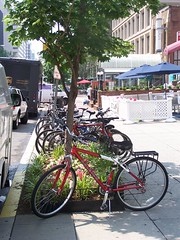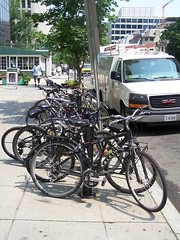Do you need bike lanes to ride a bike in the city?

Photos of bicycles parked on 19th Street NW between L and M Streets.
One of the people at the aforementioned meeting asked a question about putting in bike lanes on K Street, opining that more bicyclists use K Street than any other street in the city--because of couriers.
Now I was probably the only person who had ridden a bicycle to the meeting--maybe there were 40 people there. And I was thinking "I don't need no stinking bike lane" which reminded me of Anne Lusk's dissertation Guidelines for Greenways: Determining the Distance to, Features Of, and Human Needs Met by Destinations on Multi-Use Corridors.
Mentioning a book by Untermann and Lewicki, Accommodating the pedestrian: adapting towns and neighborhoods for walking and bicycling, and their research on the various segments of bicycle users, she writes:
Bicycle advocates tend to segregate into extremes and lobby for different facilitiesx based on physiological capabilities and purposes for the trip...characteriz[ing] the bicycling populations as 'commuters,' 'recreationists,' and 'learners.' The first group can include children who commute to school but this group is primarily comprised of individuals who commute to work. Principally athletic white young to middle aged educated males, these individuals prefer to bicycle in the road, function as a car, obey traffic regulations and push 'share the road' policies in which cars share the road with bicyclists."
This gets back to the chicken and egg of transit and alternative mode promotion. Do you build it and they will come--and this includes increasing transit frequency beyond certain base numbers (my own sense is that a bus coming every 15 minutes is pretty good, something you can count on--for the most part)--or do you wait for signs of demand--overcrowding etc.--and then add facilities. (Sort of like how the University of Michigan residence hall system didn't turn on the heat in late fall until a certain number of complaints were registered--at least that's how we students thought the system worked.)
Some of the basic provisions to accommodate bicyclist-commuters should be done whether or not you add bike lanes--have secured bike locking facilities, preferably indoors if parking is extant in the building anyway, places to lock bikes on the street, ideally lockers and showers--and this type of "infrastructure" should be provided in Downtowns and major secondary business centers anyway, and could be provided collectively (like the bike facility in Chicago's Millennium Park), or by working with fitness facilities like the YMCA, YWCA, and the DC JCC which are unlikely to register heavy usership during morning commuting hours.
For commuters, I think services like that need to be pushed over bike lanes, at least initially. Although that could be my commuter bicyclist segment biases showing. Here's a run down on the Chicago facility:
The 16,448-square-foot heated facility includes free indoor parking for 300 bikes, showers and lockers, bicycle rental and repair, and a café. The Chicago Police Lakefront Bicycle Patrol Unit is also stationed in the facility.
The $3.1 million bicycle station serves not only bike commuters and recreational bicyclists, but also runners and inline skaters. It is the nation's first bicycle parking commuter station serving a major event venue (Millennium Park) and multi-model transit center (Metra's Randolph Street station and the McCormick Place Busway connect to the Millennium Park garage).
Bicycle parking spaces are available free of charge. Cyclists can pay a small fee to use the locker rooms and showers with bike parking. Other amenities include bicycle rental, snack bar, an internet station and guided bike tours. Monthly and annual memberships are also available.
Millennium Park Bicycle Station; Click Memberships for details.

Index Keywords: bicycling; mobility



0 Comments:
Post a Comment
<< Home